Gordian III (AD 238-244) imitations
Some are typical struck silver-plated types, some are cast (below). Most are radiates. Surprisingly, some are imitations of laureate denarii (below). Three have Philip I and Philip II reverses.
Fourrees of Gordian III are distinctly less common than of earlier emperors. The reason is probably that the lower fineness of the silver makes the profit less.
What's new? 2022, May 26: Some larger and better images.
The obverse legend of all of these is
IMP GORDIANVS PIVS FEL AVG
which is used at Rome and Antioch. RIC says the Antioch pieces with this legend are "Assimilated to Roman style" and "These issues used to be attributed to Viminacium." Although I'm not sure of the import, I remark that Viminacium (an off-site link) was in upper Moesia (Kostola, on the right bank of the river Mlava, a channel of the Danube, in what was Yugoslavia), which may be in the region where these were found.
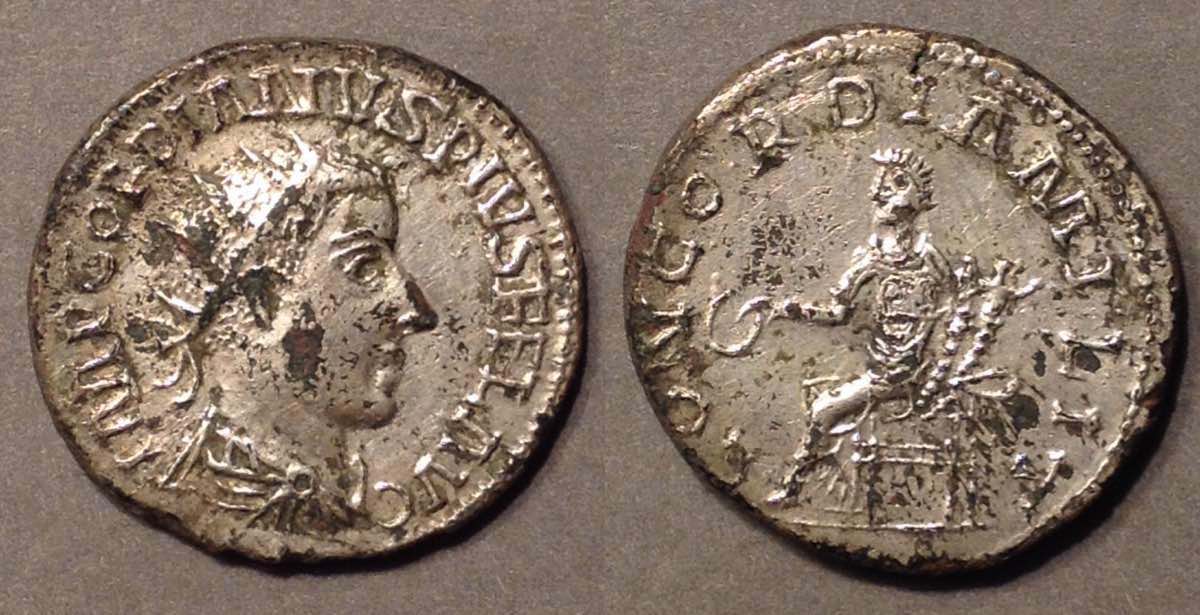 Remarkable imitation of a Gordian III 21mm. 5:00. 4.16 grams. IMP GORDIANVS PIVS FEL AVG, radiate, draped, cuirassed bust right
Remarkable imitation of a Gordian III 21mm. 5:00. 4.16 grams. IMP GORDIANVS PIVS FEL AVG, radiate, draped, cuirassed bust right
/CONCOORDIA MILIT, Concordia seated left holding patera and double cornucopiae
Prototype: RIC 65, page 23, plate 1.20.
"A clear reference to the suppression of a revolt in Africa early in 240." RIC page 2.
Inspection under a microscope shows the surface-silver is very even and very thin. I don't see how it could be silver foil. It is much thinner than typical on, say, Republican silver.
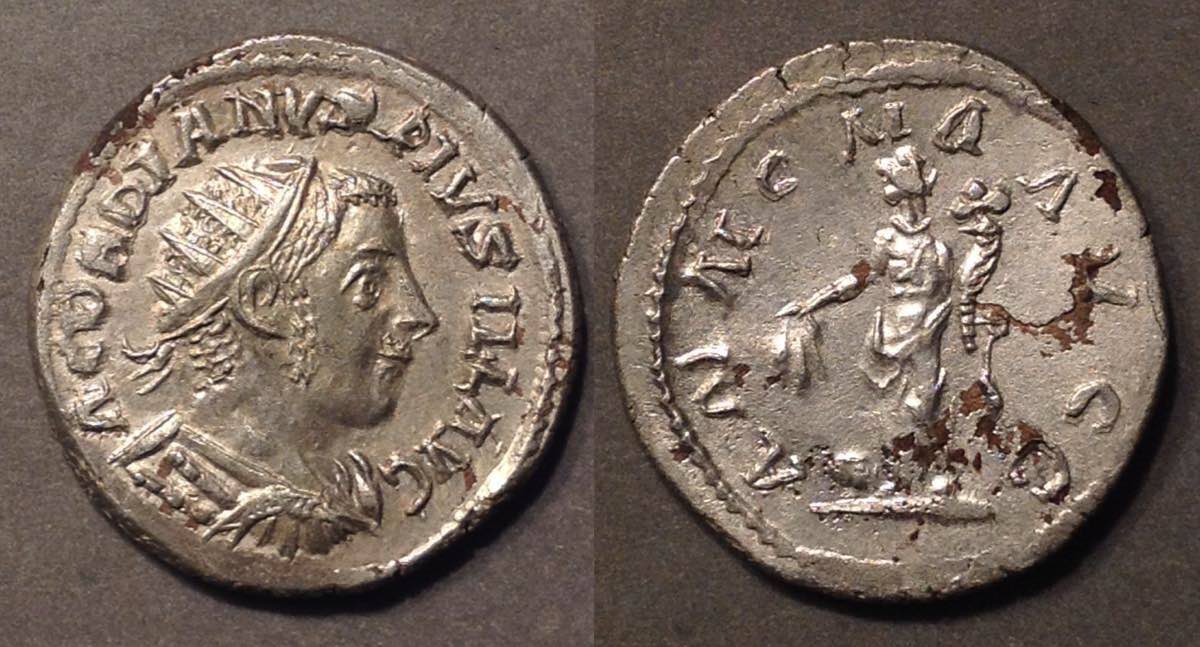 Gordian III
Gordian III
22mm. 4.83 grams. 12:00.
Superb style and preservation.
Some lettering is clear and some is blundered, like the first letter on the obverse.
[ ] GORDIANVS PIVS ILL AVG, long sideburns as on his coins from his last two years (243-4) ["ILL" should be "FEL"]
/ANNONA AVGG with the second "N" poorly engraved and each "A" lacking a crossbar. Annona standing left holding grain over delta-shaped altar.
This reverse type was not issued by Gordian III, but was by Philip I AD 245-247.
Where the silvering is unbroken, the surface looks like very high quality silver. Where is is broken, it turns immediately to copper with no silver component visible. The silvering seems to be very thin.
From a Balkan hoard of about the end of 1999.

Gordian III
21-20 mm. 4.85 grams. (Thick) 11:30.
IMP GORDIANVS PIVS FEL AVG
/PM TRP IIII COS II PP, emperor standing right holding spear and globe
RIC 92, plate 2.13, "fourth issue" 241-243. TRP IIII is 241/2.
same obverse die as the next two.
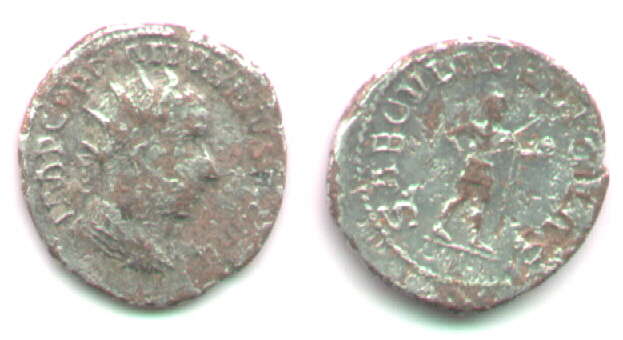
Gordian III
21-20 mm. 5:00. 3.30 grams.IMP GORDIANVS PIVS FEL AVG
/SAECVLI FELICITAS, emperor standing right holding spear and globe
Same obverse die as the two pieces immediately above. Same reverse die as the previous piece.
 Gordian III
Gordian III
22 mm. 6:00. 4.49 grams.
Cast, with some surface-silvering on the reverse. It does not look like the usual silver-foil plating of fourrés, so I suspect it is done using the technology of the later radiates under emperors such as Aurelian and Probus.
IMP GORDIANVS PIVS FEL AVG
/PM TRP IIII COS II PP, female standing left, holding cadeuceus(?) and cornucopiae.
[This is not a reverse type of Gordian III, although several of his types have this legend.]
 Gordian III
Gordian III
21-20 mm. 3.52 grams. 6:00.
IMP GORDIANVS PIVS FEL AVG, radiate, draped, and cuir. bust right
ROMAE AETERNAE, Roma seated left holding Victory with wreath, and vertical sceptre, shield below
Prototype: Sear 2459. RIC 70, p. 19, plate 1.14 "240, Jan 1 - Mar(?).
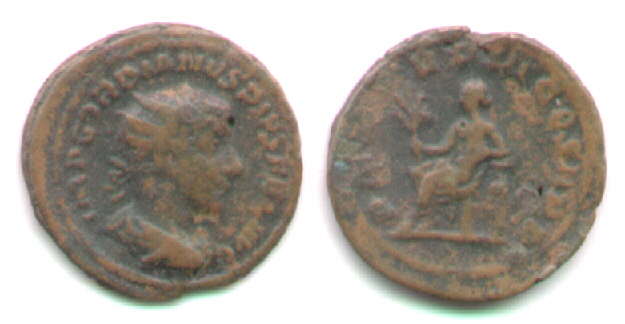 Gordian III
Gordian III
Cast. Apparently copper with no remaining silver.
AE22. 2.85 grams. 6:00.
IMP GORDIANVS PIVS FEL AVG
/PM TRP III COS II PP, Apollo seated left, holding branch and resting left elbow on lyre.
Its prototype is next.
Prototype: RIC 87, plate 2.11. Hunter 60.34 is TRP IIII, but otherwise similar.
Prototype shown: AR21. 12:00. RIC 88, plate 2.12 "241-243".
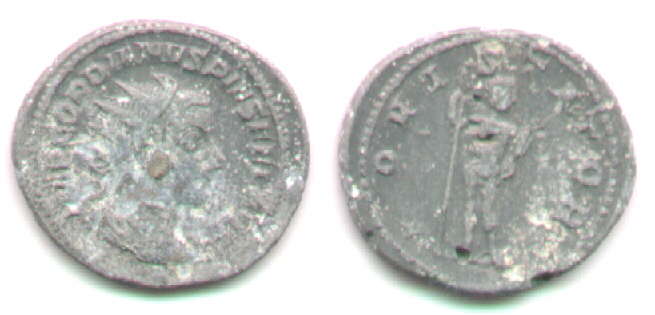
Gordian III
Gray metal. 23 mm. 12:00.
IMP GORDIANVS PIVS FEL AVG
/IOVI STATORI, Jupiter standing front, head right, with vertical staff in right hand and cradeling thunderbolt in left
Prototype: RIC 84. It has a footnote: "in base metal, C.110." Plate 2.8 variety. Hunter 61.52 has very similar reverse lettering.
Its protype is next.

Gordian III
23mm. 3.84 grams. 6:00.
Base metal. Perfect style, but no signs of silver. No edge seam.
IMR GORDIANVS PIVS FEL AVG,
MARTEM PROPVGNATOREM, Mars advancing right with spear and shield.
Prototype: Sear 4th ed. 2442.
RIC 147 "fifth issue, 243-244, 243 early sutumn - summer 244."

Hybrid of Gordian III and Philip I.
Most silvering gone. 22 mm. 12:00. 4.55 grams.
IMP GORDIANVS PIVS FEL AVG
/ADVENTVS AVGG
The reverse's prototype is next.
Official coin of Philip I:
IMP M IVL PHILIPPVS AVG
/ADVENTVS AVG
AR22. 12:30.
Sear 2450. RIC 26b "AD 245". Hunter 67.19.

Gordian III
Hybrid with Philip II
IMP GORDIANVS PIVS FEL AVG
/PRINCIPI IVVENT, emperor standing right with spear and globe
Prototype: RIC 241 "with referse of Philip II", cites BM under "hybrids."
Reverse type of Philip II, 216c, plate 8.5, of "244-246" where the sceptre is transverse.
 Gordian III
Gordian III
Hybrid with Philip II.
IMP GORDIANVS PIVS FEL AVG
/LIBERALITAS AVGG III,, Philip I and II seated left on curule chairs
RIC 241A under hybrids, page 40. RIC Philip II 230, plate 8.15, page 97, Antioch mint.
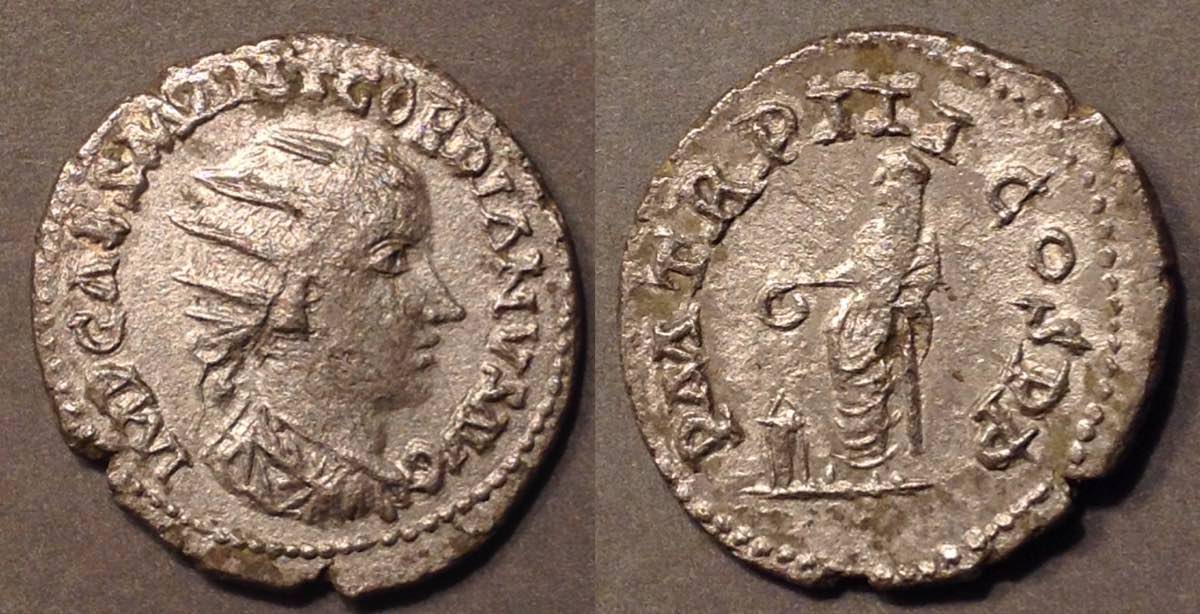 Gordian III
Gordian III
22mm. 12:00. 4.41 grams.
An unusual solid-metal (base silver?) imitation. Stuck, not cast. There are no signs of baser metal beneath. The obverse surface is grainy (from cleaning, I suppose). Even the lustrous metal on the reverse has a slightly gray cast, not like good silver.
A Gordian III mule.
IMP CAES M ANT GORDIANVS AVG, letters slightly bolder and more irregular than usual. Ear not formed. Portrait style slightly irregular.
/PM TRP III COS PP, female figure standing left holding patera over altar. The top half of the figure is to the right of the bottom half -- it is poorly engraved. Sometimes this type of appearance can come from a double strike, but this is not double struck. Again the lettering is very bold -- bolder than usual.
RIC 69 (page 23, plate 2.2) has this reverse with IMP GORDIANVS PIVS FEL AVG of the earlier "third issue" or AD 240. The obverse legend of the coin above did not begin until the following issue of 241.
I speculate that this is not the usual forgery from inside the empire, but an attempt at a reasonably valuable coin by some group north or northeast of the region controlled by the empire. I speculate the region would be in the "Black Sea area."
Denarii of Gordian III
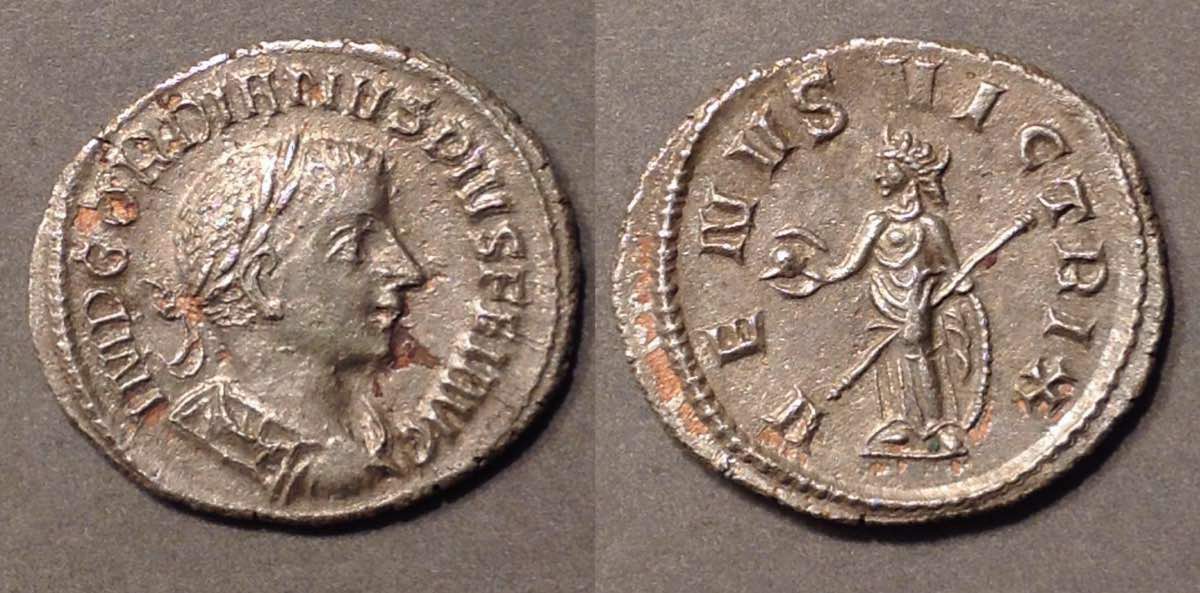 Gordian III, denarius imitation.
Gordian III, denarius imitation.
21-18mm. 6:00. 2.66 grams.
Superb denarius imitation with almost full silvering.
IMP GORDIANVS PIVS FEL AVG
/VENVX VICTRIX
Sear 2477
ex Lanz auction 109, lot 76.
 Gordian III
Gordian III
19 mm. 6:00.
Laureate! Slightly crude style with large nose. Some silver remains.
IMP GORDIANVS PIVS FEL AVG
/PAX AVGVSTI, emperor walking right with transvers spear and globe
RIC obverse legend of Antioch 242-244. The reverse legend exists, e.g. RIC 214-5, but not with this type. There are no denarii of this type with either legend.


Laureate! Imitation denarius, with thin lighter metal on some of the surface, and its prototype. As on one of the radiates above, the imitation does not look like the usual silver-foil plating of fourrees, so I suspect it is done using the technology of the later radiates under emperors such as Aurelian and Probus.
18-16 mm. 12:00. 2.62 grams.
IMP GORDIANVS PIVS FEL AVG
/AETERNITATI AVG, Sol standing left raising right hand and holding globe
Prototype: RIC 111, "fourth issue, 241-3". AR21-19, 12:00.
Continue with the page on imitations of Philip (244-249).
Return to the Index page of Severan and later imitations.
Return to the main Table of Contents page on imitations.
 Remarkable imitation of a Gordian III 21mm. 5:00. 4.16 grams. IMP GORDIANVS PIVS FEL AVG, radiate, draped, cuirassed bust right
Remarkable imitation of a Gordian III 21mm. 5:00. 4.16 grams. IMP GORDIANVS PIVS FEL AVG, radiate, draped, cuirassed bust right Gordian III
Gordian III

 Gordian III
Gordian III

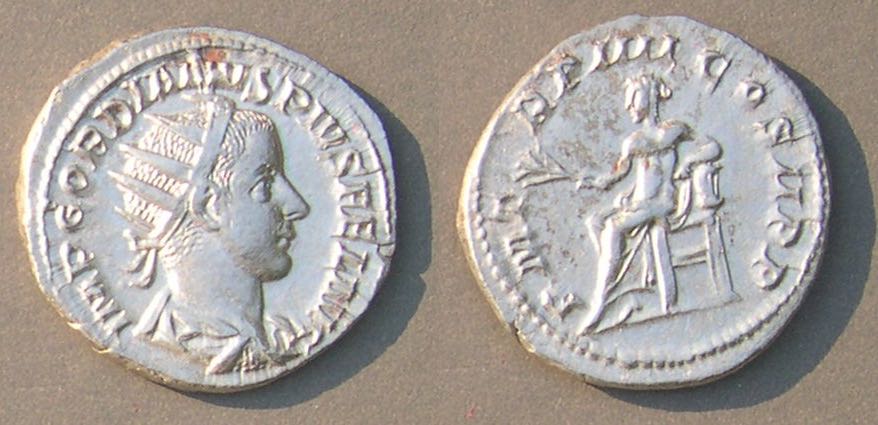




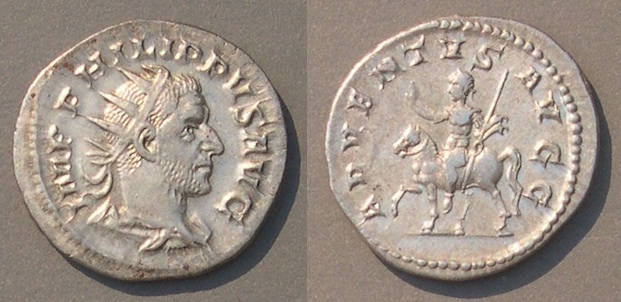


 Gordian III
Gordian III Gordian III, denarius imitation.
Gordian III, denarius imitation.

